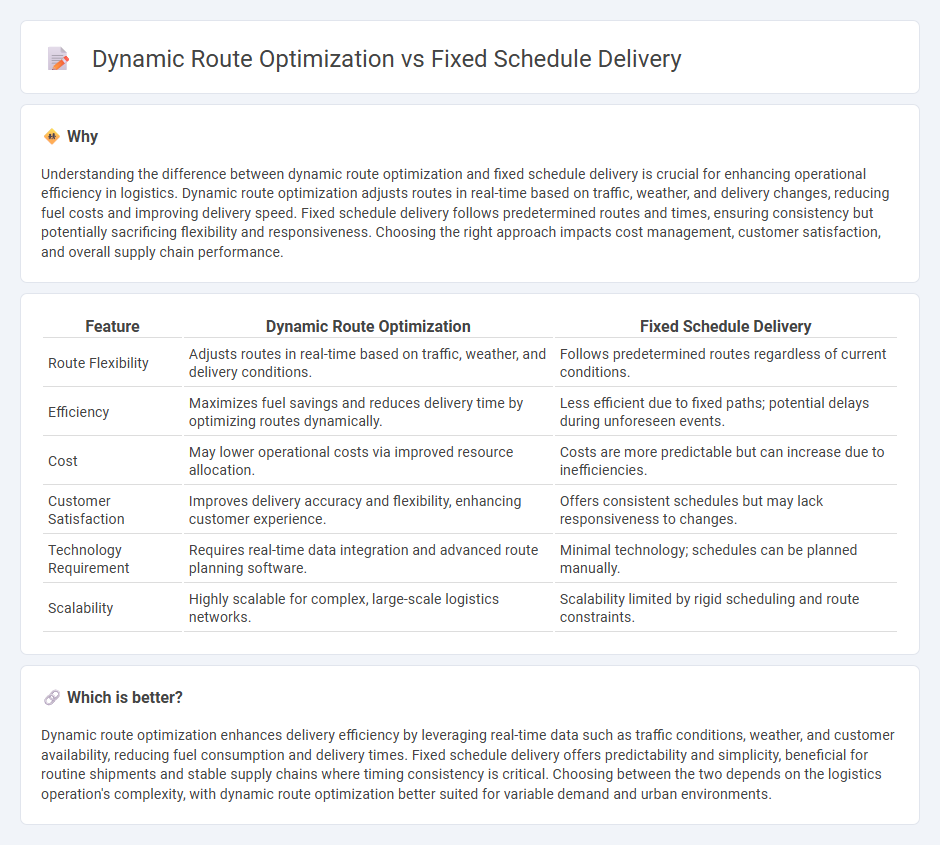
Dynamic route optimization leverages real-time data and advanced algorithms to adjust delivery paths for maximum efficiency and reduced fuel consumption, unlike fixed schedule delivery, which follows predetermined routes regardless of current traffic or demand conditions. This approach improves on-time performance, lowers operational costs, and enhances customer satisfaction by responding promptly to changes in shipment priorities and road conditions. Discover how embracing dynamic route optimization can transform your logistics operations and drive competitive advantage.
Why it is important
Understanding the difference between dynamic route optimization and fixed schedule delivery is crucial for enhancing operational efficiency in logistics. Dynamic route optimization adjusts routes in real-time based on traffic, weather, and delivery changes, reducing fuel costs and improving delivery speed. Fixed schedule delivery follows predetermined routes and times, ensuring consistency but potentially sacrificing flexibility and responsiveness. Choosing the right approach impacts cost management, customer satisfaction, and overall supply chain performance.
Comparison Table
| Feature | Dynamic Route Optimization | Fixed Schedule Delivery |
|---|---|---|
| Route Flexibility | Adjusts routes in real-time based on traffic, weather, and delivery conditions. | Follows predetermined routes regardless of current conditions. |
| Efficiency | Maximizes fuel savings and reduces delivery time by optimizing routes dynamically. | Less efficient due to fixed paths; potential delays during unforeseen events. |
| Cost | May lower operational costs via improved resource allocation. | Costs are more predictable but can increase due to inefficiencies. |
| Customer Satisfaction | Improves delivery accuracy and flexibility, enhancing customer experience. | Offers consistent schedules but may lack responsiveness to changes. |
| Technology Requirement | Requires real-time data integration and advanced route planning software. | Minimal technology; schedules can be planned manually. |
| Scalability | Highly scalable for complex, large-scale logistics networks. | Scalability limited by rigid scheduling and route constraints. |
Which is better?
Dynamic route optimization enhances delivery efficiency by leveraging real-time data such as traffic conditions, weather, and customer availability, reducing fuel consumption and delivery times. Fixed schedule delivery offers predictability and simplicity, beneficial for routine shipments and stable supply chains where timing consistency is critical. Choosing between the two depends on the logistics operation's complexity, with dynamic route optimization better suited for variable demand and urban environments.
Connection
Dynamic route optimization enhances fixed schedule delivery by adjusting routes in real-time to accommodate traffic conditions, weather changes, and unexpected delays, ensuring timely deliveries as planned. Integrated logistics systems use GPS data and predictive analytics to synchronize route adjustments with fixed time windows, improving operational efficiency and customer satisfaction. This connection reduces fuel consumption and driver overtime while maintaining strict adherence to predetermined delivery schedules.
Key Terms
Time Windows
Fixed schedule delivery relies on predetermined time windows, ensuring consistent customer expectations but often sacrificing route efficiency. Dynamic route optimization adjusts delivery paths and time windows in real-time based on traffic, orders, and driver availability to maximize efficiency and reduce delays. Explore how adapting time windows in logistics can enhance both customer satisfaction and operational performance.
Route Planning
Fixed schedule delivery follows predetermined routes with specific time windows, ensuring predictability but often leading to inefficiencies in fuel consumption and time management. Dynamic route optimization uses real-time data and algorithms to adjust delivery routes on-the-fly, maximizing efficiency by reducing travel distance and improving customer satisfaction. Explore more to understand how dynamic route optimization revolutionizes modern logistics and route planning strategies.
Demand Variability
Fixed schedule delivery struggles to adapt to fluctuating demand, often resulting in inefficiencies such as late deliveries or unused capacity. Dynamic route optimization leverages real-time data and advanced algorithms to adjust routes based on demand variability, enhancing delivery accuracy and resource utilization. Explore how businesses harness dynamic route optimization to meet changing customer demands effectively.
Source and External Links
Fixed Date Definition and Meaning - A fixed schedule delivery refers to a delivery set for a specific, unalterable date and time, ensuring precise timing for logistics operations, which helps improve customer satisfaction and operational efficiency by preventing delays and disruptions in the supply chain.
Scheduled Delivery Service - Scheduled delivery is a shipping service guaranteeing a package arrives at a specific day and time, offering flexibility with on-demand or recurring deliveries, real-time tracking, and 24/7 customer service to ensure reliability.
What is Scheduled Delivery, and How Does it Work? - Scheduled delivery allows customers to choose a precise delivery date and time to increase convenience, efficiency, and customer satisfaction, making the delivery process more reliable and tailored to individual needs.
 dowidth.com
dowidth.com